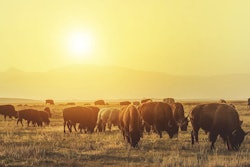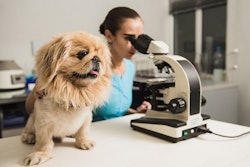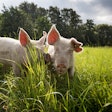
Proteins and oils from crickets, black soldier fly larvae and other insects have proven both palatable and nutritious to dogs and cats, although published, peer-reviewed research is still scanty. As scientists continue studying insects’ effects on the health of pets, other researchers aim to quantify the claim that insect-based pet food ingredients have a smaller environmental footprint than four- or two-legged livestock. At Aspire Food Group’s facility in London, Ontario, Canada, crickets will dwell in 95,000 habitats within a building the size of a regulation hockey rink, a standard unit of measure in Canada, Jennifer Maclean, Ph.D., vice president of research and innovation at Aspire said during her presentation at Petfood Forum 2022.
“As part of building that facility, we actually did track the amount of greenhouse gases that were going to be produced,” she said. “For an estimated 12,000 tonnes of crickets that are going to be produced per year, we see 31 kilotonnes of co2 equivalent emissions, which is 15% less than what you would see with chicken residuals.”
A trial run began in early May, and the facility is scheduled to be populated with crickets in June to begin regular operations. When that facility goes online, very few humans will be needed to care for the arthropod livestock. The individual cricket habitats stack like an Amazon warehouse complete with automated storage and retrieval system.
Automation of insect farm for pet food ingredients
Aspire has 13 robots to run its insect-based pet food ingredient facility, she said. The company’s engineers leveraged government funding to create the bespoke bots specifically for high-rise cricket farming.
“These robots were designed specifically by our engineers to interact with our habitats and to do everything that we need, in order to make that run very smoothly,” she said.
Likewise, the cricket facility requires 13 human operators. They work in three shifts filling all 24 hours of the day and 365 days of the year. In these days of worker shortages and hiring snarls, that can be a major advantage. A nearby chicken processing facility will need 400 staff once operational, Maclean said.
“They'll have a hard time pulling in all of the staff that they need for those kinds of roles,” she said.
Finding 13 people to work in an automated insect farm doesn’t present nearly the same difficulties. Once found, those future cricket ranchers don’t need much training. Two to six weeks is enough to get an new hire up to speed.
















